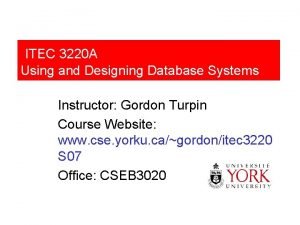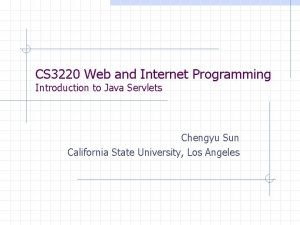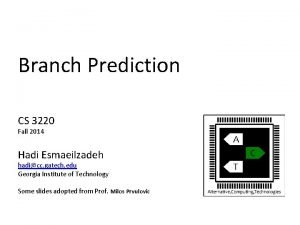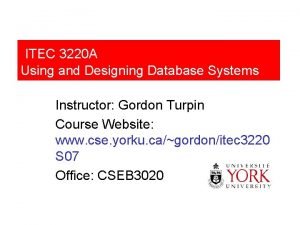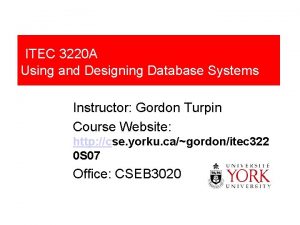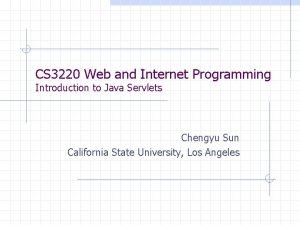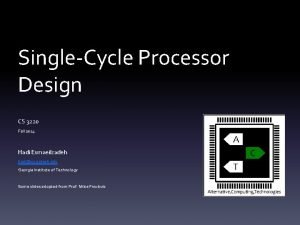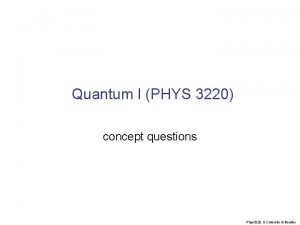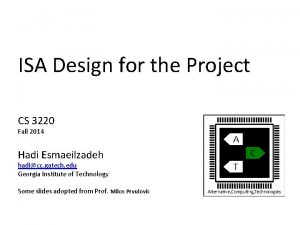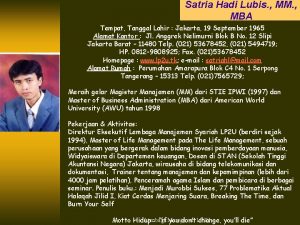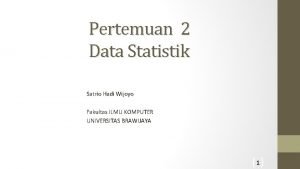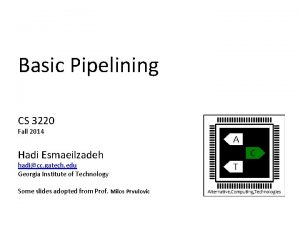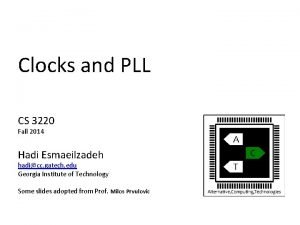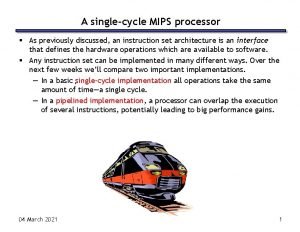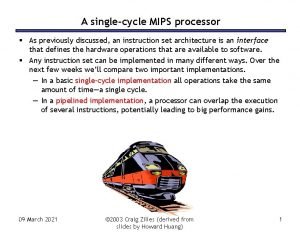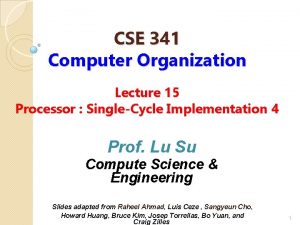SingleCycle Processor Design CS 3220 Fall 2014 Hadi




![Wire it up wire [3: 0] rregno 1=rs, rregno 2=rt; wire [(DBITS-1): 0] regout Wire it up wire [3: 0] rregno 1=rs, rregno 2=rt; wire [(DBITS-1): 0] regout](https://slidetodoc.com/presentation_image_h/b88a3db17766c599de835e30d96d8b63/image-5.jpg)






![Single-cycle Supported: ALUR, ALUI LW, SW BCOND M X aluout[0] 4 P C Instr Single-cycle Supported: ALUR, ALUI LW, SW BCOND M X aluout[0] 4 P C Instr](https://slidetodoc.com/presentation_image_h/b88a3db17766c599de835e30d96d8b63/image-12.jpg)


- Slides: 14

Single-Cycle Processor Design CS 3220 Fall 2014 Hadi Esmaeilzadeh hadi@cc. gatech. edu Georgia Institute of Technology Some slides adopted from Prof. Milos Prvulovic

Single-Cycle Approach • Entire instruction done in only one cycle • Data-moving takes only time it really needs (wires) – • • Control takes only as much time as it really needs – Figure out all control signals right after inst read from imem – Takes only part of one cycle, because one is all we have All major units get used in every cycle – • • E. g. dedicated wire to take reg output to ALU input Unless the unit is not needed for a specific instruction But…“enhancements” become “necessities” – Example: Branch uses ALU to compare, need separate PC+4+4*imm – Each cycle, need to read two registers read and writte one – Etc. And… longest-to-do instruction determines clock – Usually a load, so all other insts will have slack for memory read 2

Single-cycle Supported: ADD + 4 P C Control Instr Mem RF 3

Look at that register file! module Reg. File(RADDR 1, DOUT 1, RADDR 2, DOUT 2, WADDR, DIN, WE, CLK); parameter DBITS; // Number of data bits parameter ABITS; // Number of address bits parameter WORDS = (1<<ABITS); parameter MFILE = ""; reg [(DBITS-1): 0] mem[(WORDS-1): 0]; input [(ABITS-1): 0] RADDR 1, RADDR 2, WADDR; input [(DBITS-1): 0] DIN; output wire [(DBITS-1): 0] DOUT 1, DOUT 2; input CLK, WE; always @(posedge CLK) if(WE) mem[WADDR]=DIN; assign DOUT 1=mem[RADDR 1]; Three separate accesses • Two reads • One write Each with it own address! assign DOUT 2=mem[RADDR 2]; endmodule 4
![Wire it up wire 3 0 rregno 1rs rregno 2rt wire DBITS1 0 regout Wire it up wire [3: 0] rregno 1=rs, rregno 2=rt; wire [(DBITS-1): 0] regout](https://slidetodoc.com/presentation_image_h/b88a3db17766c599de835e30d96d8b63/image-5.jpg)
Wire it up wire [3: 0] rregno 1=rs, rregno 2=rt; wire [(DBITS-1): 0] regout 1, regout 2; wire [3: 0] wregno=rd; // This comes from decoding logic // (reg becomes wire in non-edge always block) reg wrreg; reg [(DBITS-1): 0] wregval; // Now instantiate the register file module Reg. File #(. DBITS(DBITS), . ABITS(5), reg. File(. RADDR 1(rregno 1), . DOUT 1(regout 1), . RADDR 2(rregno 2), . DOUT 2(regout 2), . WADDR(wregno), . DIN(wregval), . WE(wrreg), . CLK(clk)); 5

Wire it up - ALU // ALU input 1 is always the first source register wire [(DBITS-1): 0] aluin 1=regout 1; // ALU input 2 is decided by control logic // (either regout 2 or immediate) reg [(DBITS-1): 0] aluin 2; // Decided by control logic reg [4: 0] alufunc; // Output of the ALU (becomes wire b/c of always block below) reg [(DBITS-1): 0] aluout; always @(alufunc or aluin 1 or aluin 2) case(alufunc) OP 2_AND: aluout=aluin 1&aluin 2; . . . // Same as in Project 2. . . // but uses aluin 1 and aluin 2 instead of A and B // Used by control logic for conditional branches wire cond=aluout[0]; 6

Control Logic always @(opcode 1 or opcode 2 or ry or rz) begin {aluimm, alufunc, isbranch, isjump, wrmem}= { 1'b. X, 5'h. XX, 1'b 0, 1'b 0}; {selaluout, selmemout, selpcplus, wrreg}= { 1'b. X, 1'b 0}; case(opcode 1) OP 1_ALUR: {aluimm, { alufunc, selaluout, selmemout, selpcplus, wrreg}= 1'b 0, {1’b 0, op 2_i}, 1'b 1, 1'b 0, 1'b 1}; OP 1_ALUI: {aluimm, { alufunc, 1'b 1, {1’b 0, op 2_t}, selaluout, selmemout, selpcplus, wrreg}= 1'b 1, 1'b 0, 1'b 1}; … 7

Single-cycle 4 P C Supported: ADD, ADDI Control Instr Mem RF M X SE 8

Single-cycle 4 P C Supported: All ALUR, ALUI insts Control Instr Mem RF M X SE 9

Single-cycle 4 P C Supported: ALUR, ALUI LW Control Instr Mem RF M X A Data Mem M X SE 10

Single-cycle 4 P C Instr Mem Supported: ALUR, ALUI LW, SW Control RF A M X D Data Mem M X SE 11
![Singlecycle Supported ALUR ALUI LW SW BCOND M X aluout0 4 P C Instr Single-cycle Supported: ALUR, ALUI LW, SW BCOND M X aluout[0] 4 P C Instr](https://slidetodoc.com/presentation_image_h/b88a3db17766c599de835e30d96d8b63/image-12.jpg)
Single-cycle Supported: ALUR, ALUI LW, SW BCOND M X aluout[0] 4 P C Instr Mem Control RF A M X D Data Mem M X SE 12

And it’s not done yet! Supported: ALUR, ALUI, LW, SW, BCOND JAL M X 4 P C Instr Mem Control RF A M X D Data Mem M X SE 13

How do we do all this? • The only real “state” is the PC, Regs, and Mem – The rest is just wires and combinatorial logic • Central control takes opcode, generates all signals for the entire instruction! • But can have other small pieces of control – E. g. decide if PC+4 or PC+4+Offs loaded into PC on a conditional branch instruction, or to load a register for the JAL instruction 14
